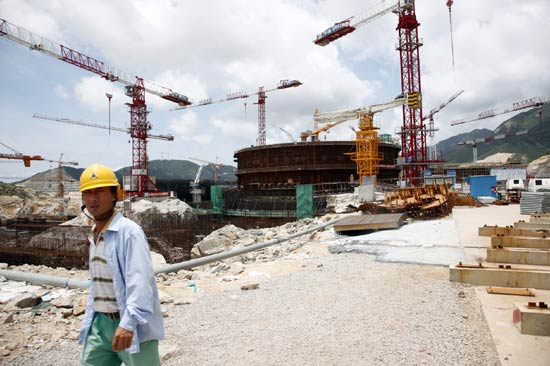Energy
Expert: Power goal is attainable
By Liu Yiyu (China Daily)
Updated: 2011-05-13 09:09
 |
Large Medium Small |
|
 A worker walks near the Taishan 1 Areva SA EPR reactor at the China Guangdong Nuclear Power Group Co atomic plant in Taishan, Guangdong province, in July 2010. New projects in their preliminary stages or awaiting approval will remain on hold because of the Japanese crisis. [Photo / Agencies] |
China 'will reach 70 gW capacity' despite nuke plant approval freeze
BEIJING - China is likely to achieve its target of 70 gigawatts (gW) in nuclear capacity by 2020 despite its freeze on approving new nuclear projects since Japan's nuclear crisis, Xu Yuming, vice-secretary general of the China Nuclear Energy Association (CNEA), said on Thursday.
"China will reach at least 70 gW in nuclear capacity by 2020," Xu said. "Eighty gW is also possible."
The country could attain 50 gW of nuclear capacity by 2015, with projects totaling 40 gW of capacity under construction now, Xu said.
As of the end of 2010, China had 10.8 gW of nuclear capacity, according to the National Energy Administration (NEA).
Japan's nuclear crisis has no impact on the long-term development of China's nuclear sector, Xu said, though the enthusiasm for building nuclear reactors has diminished.
The sector has been growing at the rate of six to eight new reactors a year.
| ||||
Nevertheless, preliminary work on China's first inland nuclear project, the Taohuajiang Nuclear Power Plant, is still in progress, according to the Hunan-based nuclear expert, Zou Shuliang, of the China Atomic Energy Authority (CAEA).
That project and two other inland nuclear power plants, in Hubei and Jiangxi provinces, were expected to receive approval and start construction in 2011.
Review groups, consisting of 60 to 70 experts each, have concluded the safety inspections on the nuclear power plants at Daya Bay in Guangdong province, Qinshan in Zhejiang and Tianwan in Jiangsu. The reports will be issued by the end of May.
The government will then begin conducting safety reviews of the projects already under construction.
China will adopt third-generation AP 1000 technology in all new projects starting around 2015, when it is expected to complete assimilating and localizing the technology designed by US-based Westinghouse Electric Co LLC, said Xu.
Another 10 reactors, including six inland units, will adopt the third-generation technology earlier, according to the original plan, in 2011, said Zhu Shutang, director of the large advanced PWR project office of the State Nuclear Power Technology Corp (SNPTC).
The SNPTC, which introduced the technology in China, already started preliminary work on third-generation technology for the inland nuclear power plants in Hubei, Hunan and Jiangxi provinces.
Shortages of personnel and uranium supply remain issues that must be resolved as the nation heads toward becoming the largest developer of nuclear power plants.
"We have only six to seven schools training professionals for the nuclear industry," said Zou of the CAEA.
"We will be understaffed if China achieves the target of 70 gW by 2020."
Meanwhile, a professional emergency rescue team and system should be set up soon, Zou added.
China's annual consumption of uranium will rise sharply, reaching 20,000 tons by 2020, the World Nuclear Association said. China imported 17,136 tons of uranium last year, three times the amount of the previous year.
Despite questions about securing an adequate uranium supply for the expansion plans, Xu, of the CNEA, said China will without doubt have enough for 80 gW of nuclear capacity.
| 分享按钮 |



